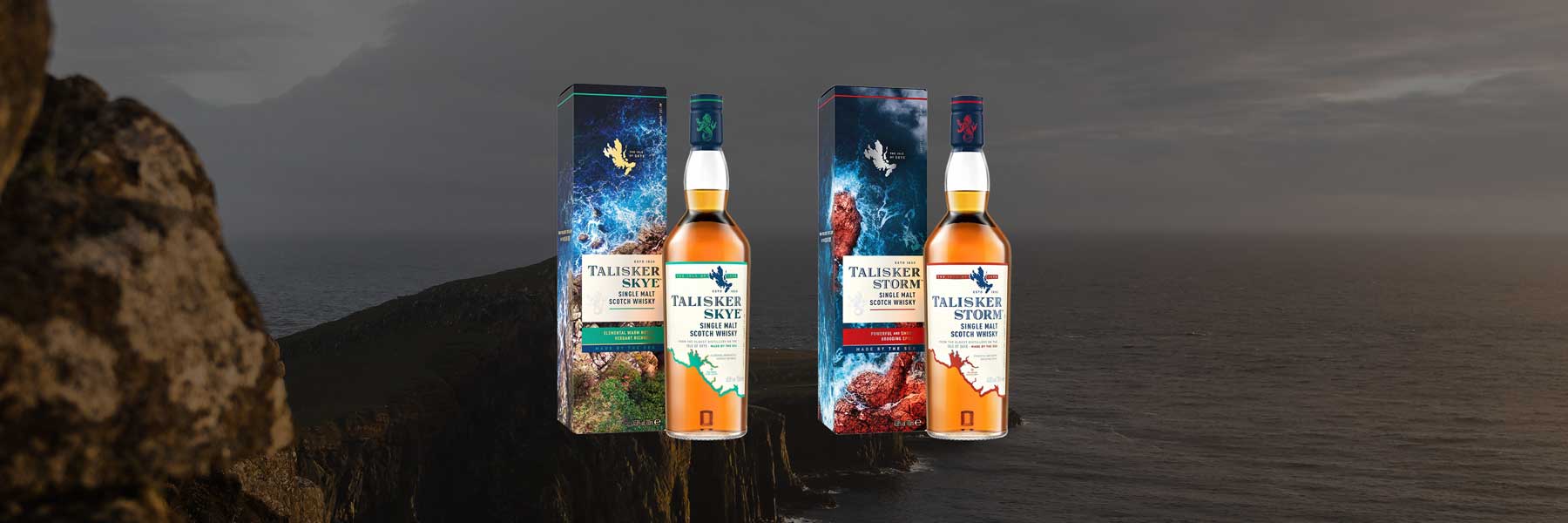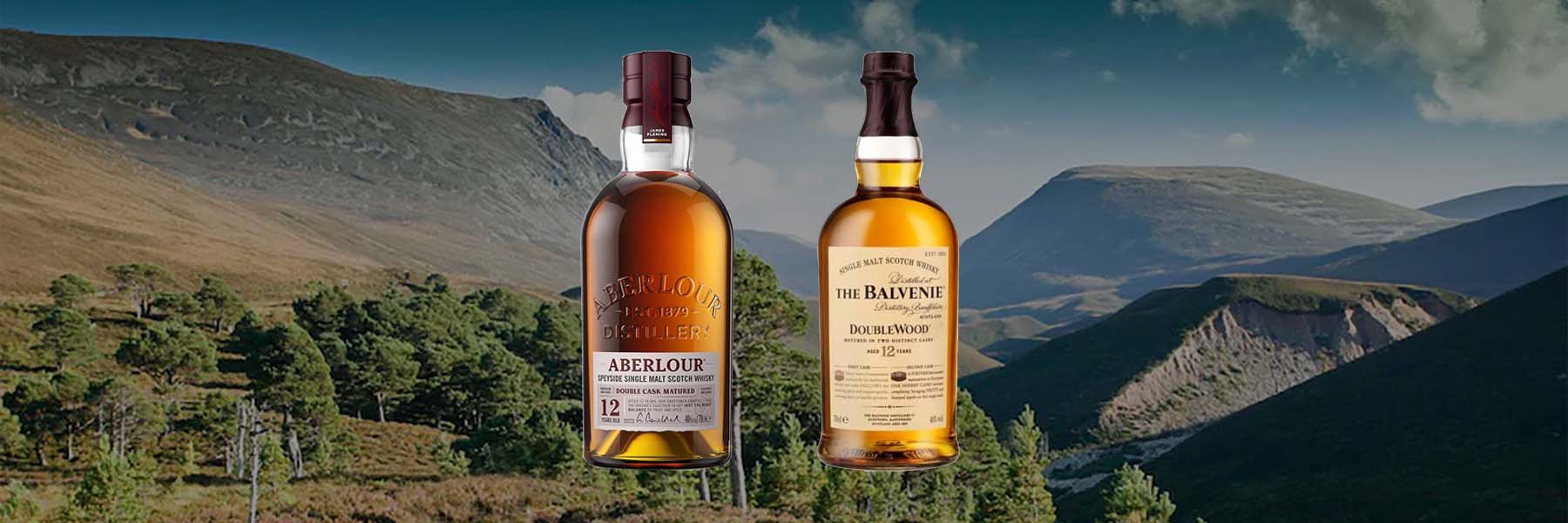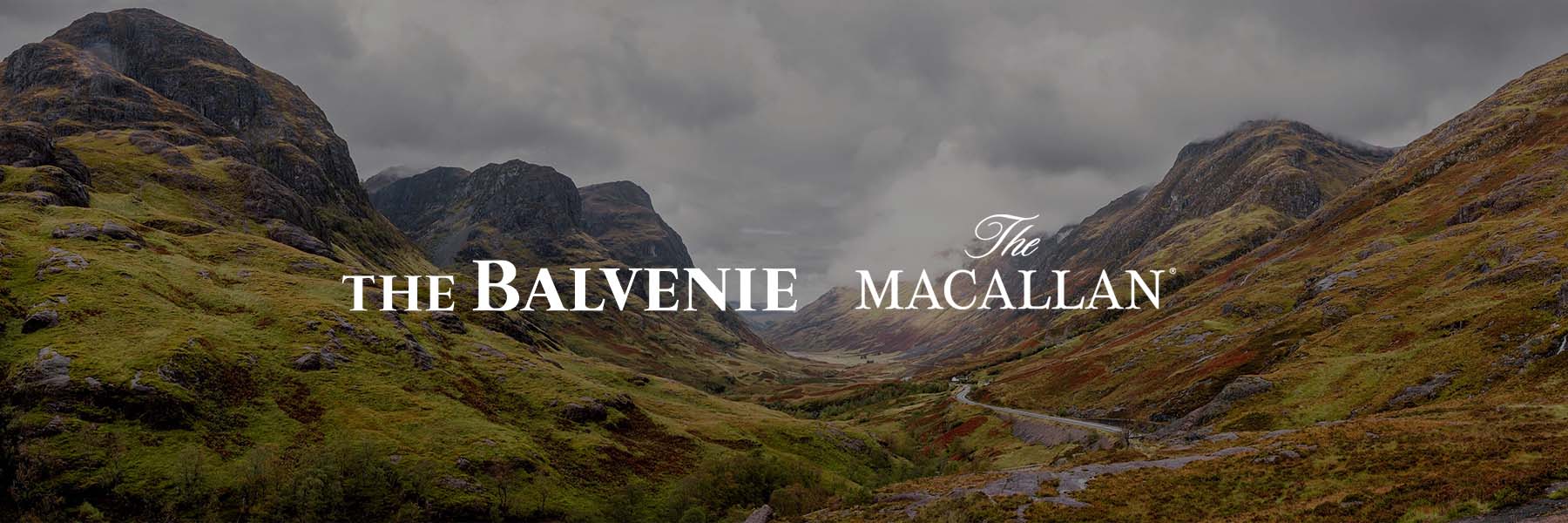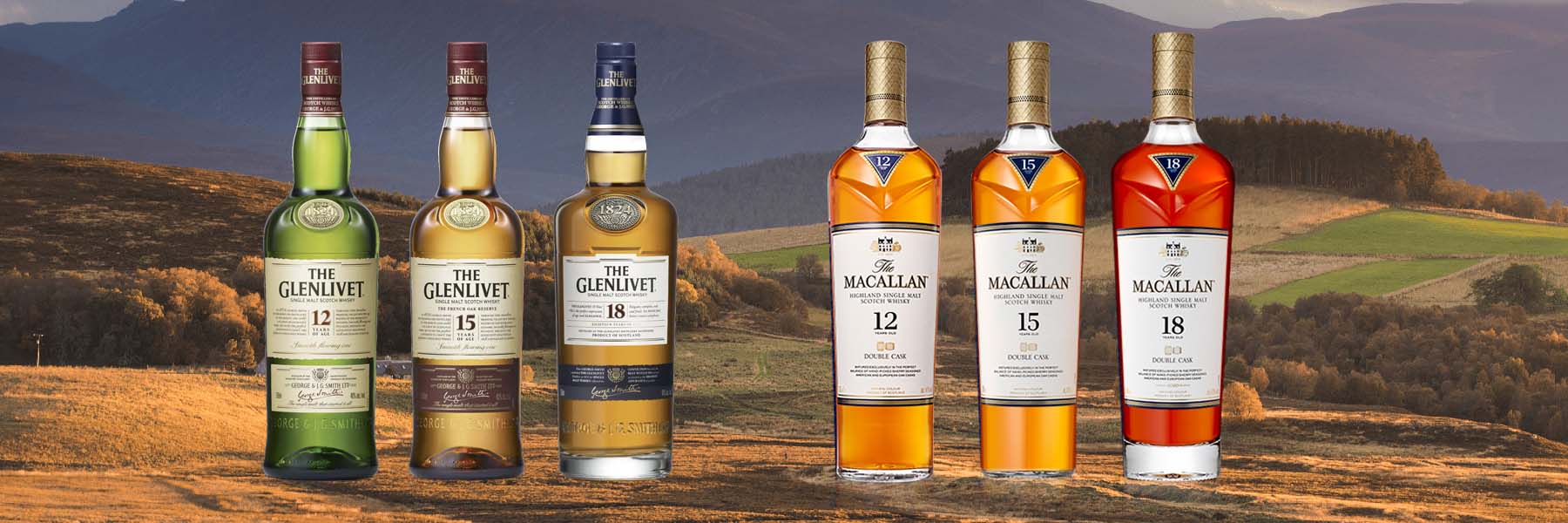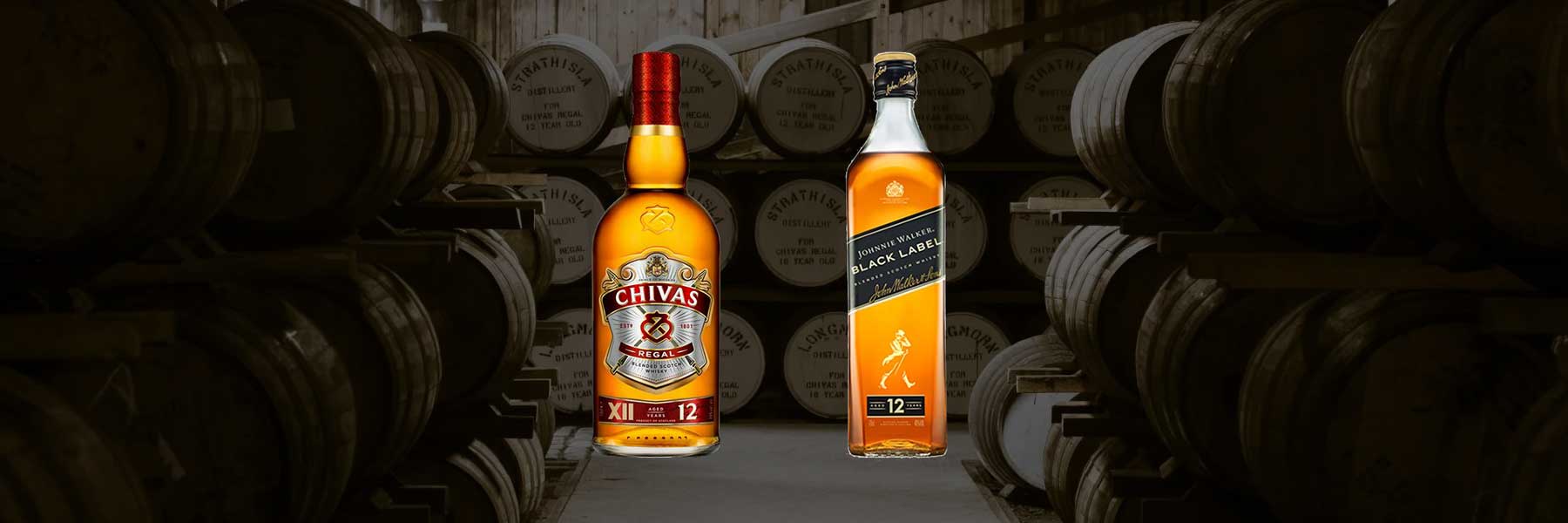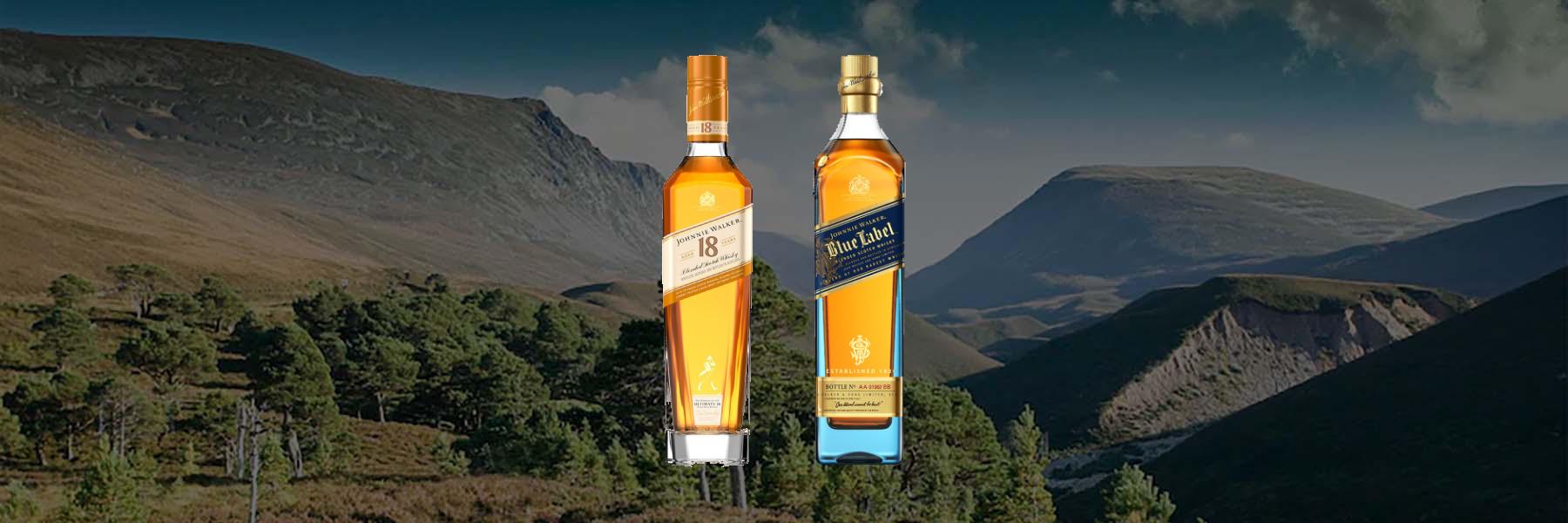Talisker Skye vs Talisker Storm
Last updated on August 13th, 2024
The Isle of Skye is home to one of Scotland’s oldest and most beloved whisky distilleries, Talisker. For over 180 years, Talisker has been crafting award-winning single malt whiskies from its home on the rugged west coast of Scotland.
Alongside Talisker’s famous 10 year old single malt whisky are an auxiliary range of subset expressions, including the Talisker Skye and Talisker Storm. Designed to accentuate different aspects of the distillery’s character, both whiskies focus on particular flavours which we’ll explore in their reviews below.
In this article, we’ll explore the differences between Talisker Skye vs Talisker Storm to help you decide which one is the perfect choice for you.
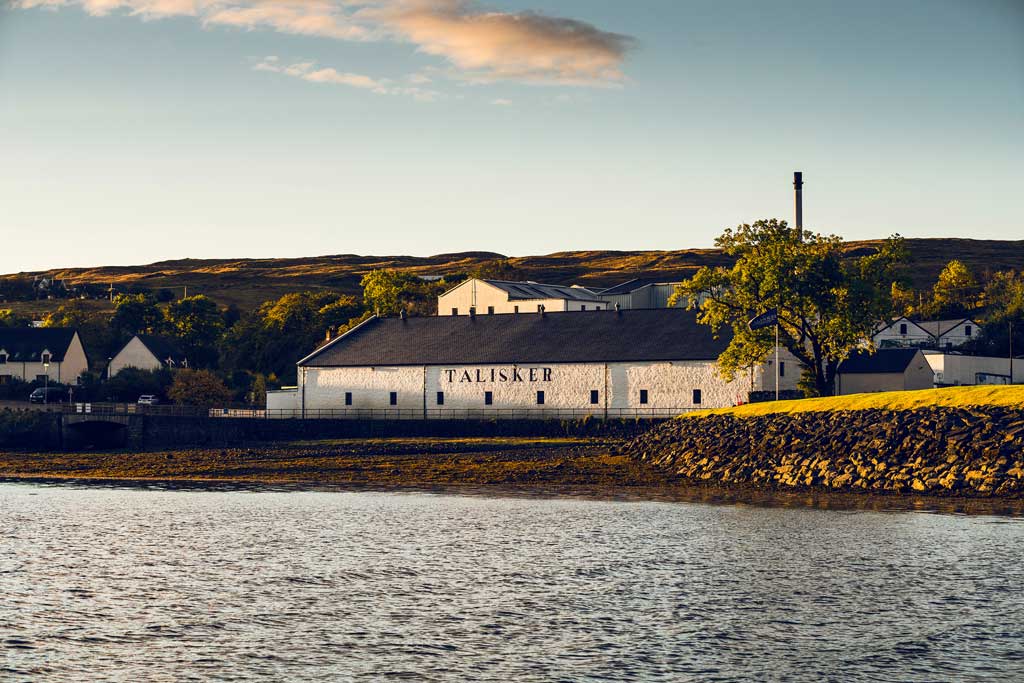
Quick Talisker backstory
Located on the Isle of Skye, Scotland, the Talisker distillery is renowned for its peaty, smokey and agreeably spicy whiskies.
Talisker has become a symbol of quality and craftsmanship in the whisky world. The origins of Talisker can be traced back to the 1830s, when Hugh and Kenneth MacAskill, two brothers from the Isle of Skye, decided to set up a distillery in the small village of Carbost. The brothers had recently acquired a farm in the area and thought it would be a good place to build their distillery.
The first stills were made from copper and the brothers began distilling their own whisky. In 1892, the MacAskill brothers sold the distillery to the MacDonald brothers, who had been running a successful distillery in nearby Portree. Under their ownership, the distillery was expanded and the first Talisker whisky was released in 1897.
It quickly became popular among whisky drinkers and the distillery soon gained a reputation for producing high-quality single malts. During the 20th century, Talisker continued to produce high-quality whisky and was frequently praised by connoisseurs and critics alike. In the 1960s, the distillery was purchased by the global company, Diageo. Under their ownership, the distillery became well known around the world. In 1960 the still-house burned down but was soon rebuilt in 1862.
Today, Talisker offers some of the most favoured single malt whiskies in the world. It is still made in Carbost, using the same traditional methods that have been used since the distillery was founded. The MacAskill brothers have long since passed, but their legacy lives on in the bottle of Talisker that continues to be enjoyed by whisky lovers around the world.
Talisker Storm was first released in 2013, with no age statement. Since then, it has won numerous awards, including a Gold Medal at the International Spirits Challenge and a Double Gold Medal at the San Francisco World Spirits Competition.
Talisker Skye, which is named after the lovely island where the distillery is located, was first introduced in early 2015. The same year this single malt was awarded a Silver Medal at The Scotch Whisky Masters, and two years later in 2017 a Silver Medal at the International Wine & Spirit Competition.
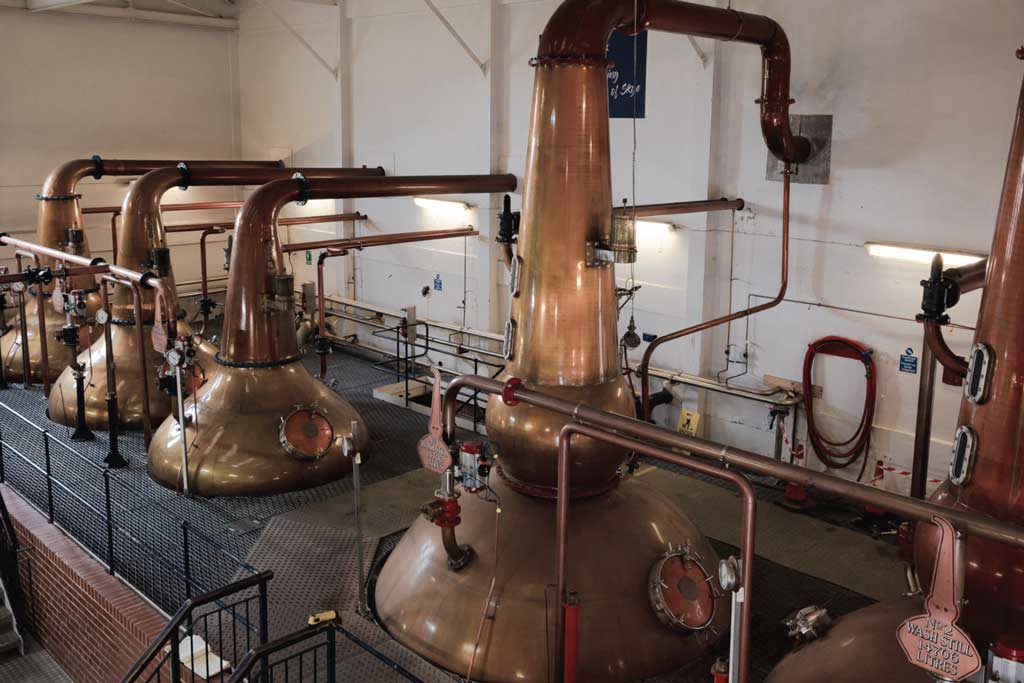
Making Talisker whisky
Getting their grain
Talisker sources their grain from the Glen Ord malting plant, just north of Inverness in Scotland. Also owned by Diageo, this is where the barley is malted – involving a three step process of steeping, germination and kilning which gives the grain its peaty flavours and smoky aromas. The malted barley is then sent to Carbost, Skye at the Talisker distillery.
Milling
First the barley is crushed using a motorised Porteus mill which grinds the grain into a coarse flour mixture of varying particle sizes called grist. Milling breaks the outer husks, allowing the natural sugars and starches to be released during the mashing process.
Mashing
The grist is then added to a large stainless steel tank called a mash tun which is then filled with hot water. The heat extracts the sugars from the barely, which is released into the water. The grist is drained and soaked twice more to extract the maximum amount of sugars into a liquid called wort. Sustainably, Talisker sends the remaining solids away (draff) to be used for cattle feed.
Beer time
The wort is transferred to a series of large wooden tanks called washbacks. Made from Oregon pine, these sizable vessels hold 53,000 litres of the sugary liquid which is then fermented with yeast. Over a 65 hour period, the yeast feeds on the sugars which are then converted to a 7.5% ABV distillers beer known as wash.
Distillation
The wash is poured into either of Talisker’s two wash stills. These bulbous, pear-shaped pot stills are steam heated which begins to boil the wash within. Alcoholic vapours rise upwards through the still-neck, making their way out the top and into a pipe which passes through a traditional worm tub. This old fashioned condenser cools the vapour which becomes a 23% ABV liquid known as low wines.
Strangely, Talisker has an odd number of spirit stills. They usually work in pairs with the wash stills (1:1). However it’s rumoured this configuration stems from the old Western Isles triple distillation method.
The low wines are then added to one of the three spirit stills which is then distilled once more. This redistillation produced a much stronger 70% ABV liquid called new make spirit.
Maturation
The new make spirit is then transported to Glasgow. There, it’s predominantly aged in hogshead casks which are re-built from ex American bourbon barrels. For some of their whiskies, ex-European sherry butts are also used for maturation which imbue notes of dried fruit, nuts and spice.
Bottling
Talisker Skye and Talisker Storm are made by marrying various single malts from other casks. As they each have their own characteristics, casks of varying ages are used to achieve consistent flavour, depth and complexity. These can range between 3 and 25 years old!
For clarity and to prevent cloudiness at low temperatures, both the Skye and the Storm single malts are chill filtered. They are also both coloured using E150a caramel colouring. They are then bottled at Talisker’s signature of ABV 45.8% (91.6% proof).
Distillery character
If you’re unfamiliar with Talisker, their new make spirit is characteristically spicy. This is due to the minimal copper-contact within their stills whilst creating a large amount of reflux. Combined, their still shapes, kinked lyne arms and use of traditional worm tub condensers create a renowned pepperiness within their new make.
Using peated malt, Talisker whiskies are generally quite smoky with notes of sulphur and spicy heat. Depending which expression you choose, these are the baseline characteristics of their single malt whiskies.
Let’s take a closer look.
Talisker Skye vs Talisker Storm
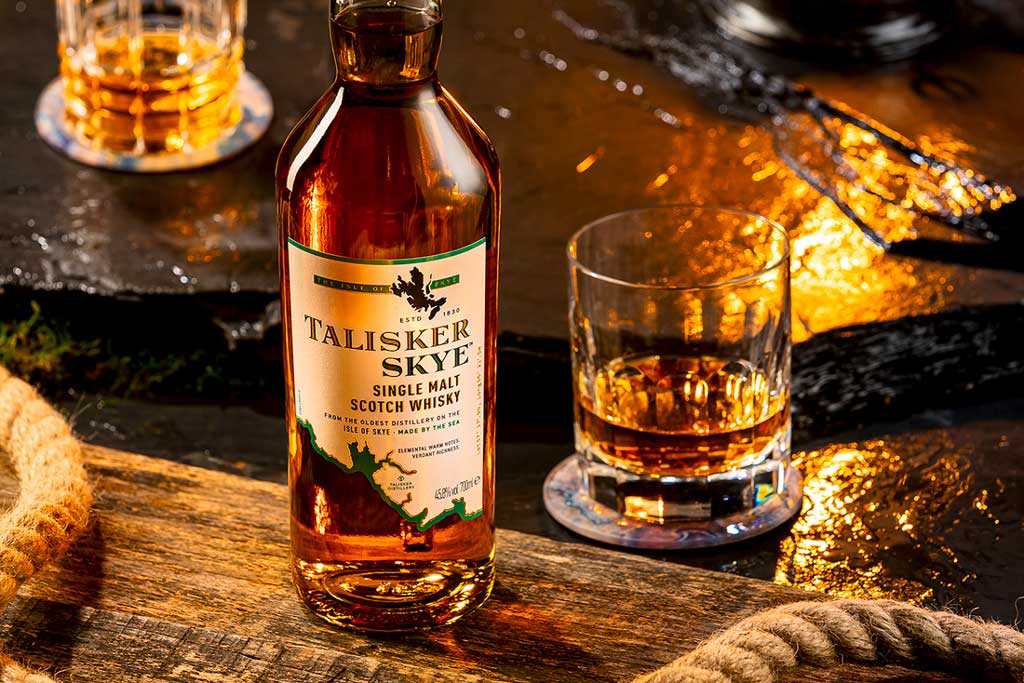
Talisker Skye tasting notes
Nose: Sweet, toffee, light fruits, lemon peel, strawberry Starburst and vanilla at the end it becomes honeyed.
Palate: Strong pepper at the front, chocolate, honey, red fruits, dried raspberries and cranberries. At the back it’s dry, with a bit of smoke.
Finish: Dry, not as sweet as before, with a little more smoke.
Price: $50 / £41
Talisker Skye review
Talisker Skye is a no-age-statement single malt made from whiskies which have been aged in a combination of American oak ex-bourbon casks and newly charred casks. This marriage of maturation accentuates the Skye’s notes of vanilla and with subdued notes of spice. Compared to typical Talisker whiskies, their Skye bottling is lightly peated, toning-down their signature pepperiness for an easier-to-approach dram.
The flavour profile is complex and well-balanced. On the nose, there are notes of sweet smoke, seaweed, and a hint of citrus. On the palate, it is sweet and smoky, with a hint of spice and a slight bitterness. The peat smoke is prominent, but not overwhelming, and there are notes of honey, toasted oak, and dried fruit. The finish is dry and smoky, with a hint of pepper and some sweetness.
Talisker Skye is an excellent whisky for sipping neat or with a few drops of water. It is also a great choice for cocktails, such as an Old Fashioned or a Rob Roy.
While it can be enjoyed on its own, Talisker Skye is also a great whisky to pair with food. The smoky, peaty flavour pairs wonderfully with strong cheese such as mature cheddar, blue cheese, and Gouda. The smokiness of the whisky cuts through the richness of the cheese and the flavours of both are enhanced.
Smoked salmon and the smoky flavour of the Skye blend exceptionally well. The whisky also helps in enhancing the salmon’s delicate flavour by cutting through its fatty richness.
Game meat like venison, pheasant, and duck are also great options. The whisky is robust enough to compete with the intense flavours of the game without overpowering them.
These are just a few of the many food pairings that can be enjoyed with Talisker Skye. Whether you’re looking for something to pair your whisky with, or just looking for a delicious meal to enjoy, these food pairings are sure to please.
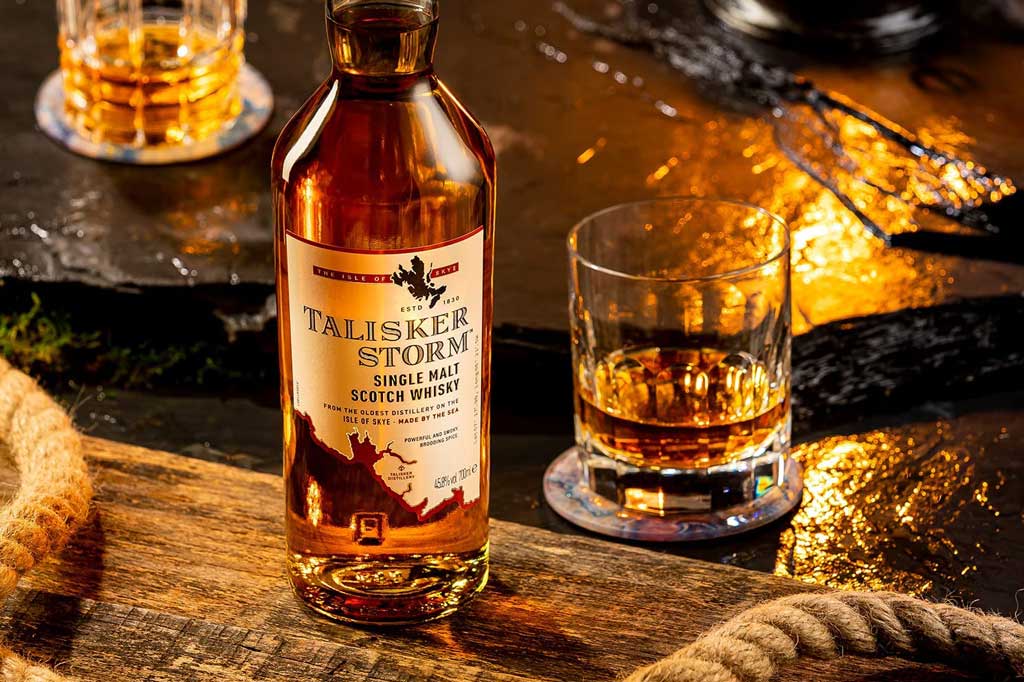
Talisker Storm tasting notes
Nose: Creamy, but not as abrupt as the 10-Year-Old. Barbecues, citrus with a hint of sticking plasters, banana. White pepper towards the bottom of the glass.
Palate: Thick, wood smoke, chilli heat, brine, tin.
Finish: Oak dryness, red chilli peppers with a hint of embers.
Price: $52 / £43
Talisker Storm review
Talisker Storm is much more heavily peated than the Skye, and is saltier and smokier on the nose. Elevating all the spicy, peppery notes, the Storm is an amped-up version of their core 10 year old expression with bags of smokiness. As a no-age-statement bottling, the Storm plays on the peaty nature of their malt, with much more of that signature Talisker heat.
On the nose, it has a strong smokiness, with notes of pepper, dried fruit, and a hint of sweetness. There are also notes of citrus and sea spray. The palate of Talisker Storm has a robust flavour, with notes of smoke, pepper, and fruit. There are also hints of citrus, oak, and a hint of sweetness. The finish is long and smoky, with a sweetness and lingering white pepper warmth.
Talisker Storm is a bold and smoky whisky, with an underlying sweetness and complexity that makes it an interesting and enjoyable dram. It pairs well with a variety of foods, and is an excellent choice for a smoky, robust flavour.
When pairing the Talisker Storm with food, it is important to match the smoky and peaty notes with bold flavours that can stand up to the intensity of the whisky. Rich, hearty dishes like steak and potatoes or barbecued ribs pair well with Talisker Storm, as do game meats such as venison.
Seafood is also a good choice for pairing, especially dishes featuring smoked salmon or scallops. The smoky and peaty notes of the whisky will enhance the flavour of the seafood, while the citrus notes will help to cut through the richness of the dish.
Cheese can also be a good choice to try with Talisker Storm. Hard cheeses like cheddar and Gruyere are a good choice, as they can stand up to the peaty and smoky flavours of the whisky. Soft cheeses like blue cheese or Camembert are also a good choice, as they will help to complement the whisky’s sweetness.
Finally, desserts like dark chocolate mousse or flourless chocolate cake are a great choice for food pairing. The whisky’s smoky and peaty notes will enhance the flavour of the chocolate, while the sweet and citrus notes will add balance to the dish.
Talisker Storm is a truly unique and special whisky, and it pairs well with a variety of dishes. By matching the smoky and peaty notes with bold flavours, you can create a truly unique and memorable dining experience.
Talisker Skye | Talisker Storm | |
| Colour | Bright gold | Amber-gold |
| Nose | Sweet, toffee, light fruits, lemon peel, strawberry Starburst and vanilla at the end it becomes honeyed. | Creamy, but not as abrupt as the 10-Year-Old. Barbecues, citrus with a hint of sticking plasters, banana. White pepper towards the bottom of the glass. |
| Palate | Strong pepper at the front, chocolate, honey, red fruits, dried raspberries and cranberries. At the back it’s dry, with a bit of smoke. | Thick, wood smoke, chilli heat, brine, tin. |
| Finish | Dry, not as sweet as before, with a little more smoke. | Oak dryness, red chilli peppers with a hint of embers. |
| Rating | 7.3/10 | 8.1/10 |
| Age | NAS | NAS |
| Region | Isle of Skye | Isle of Skye |
| ABV | 45.8 | 45.8 |
| Classification | Single Malt | Single Malt |
| Cask | American oak and refill | American oak and refill |
| Chill filtered | Yes | Yes |
| Price (USD/GBP) | $50 / £41 | $52 / £43 |
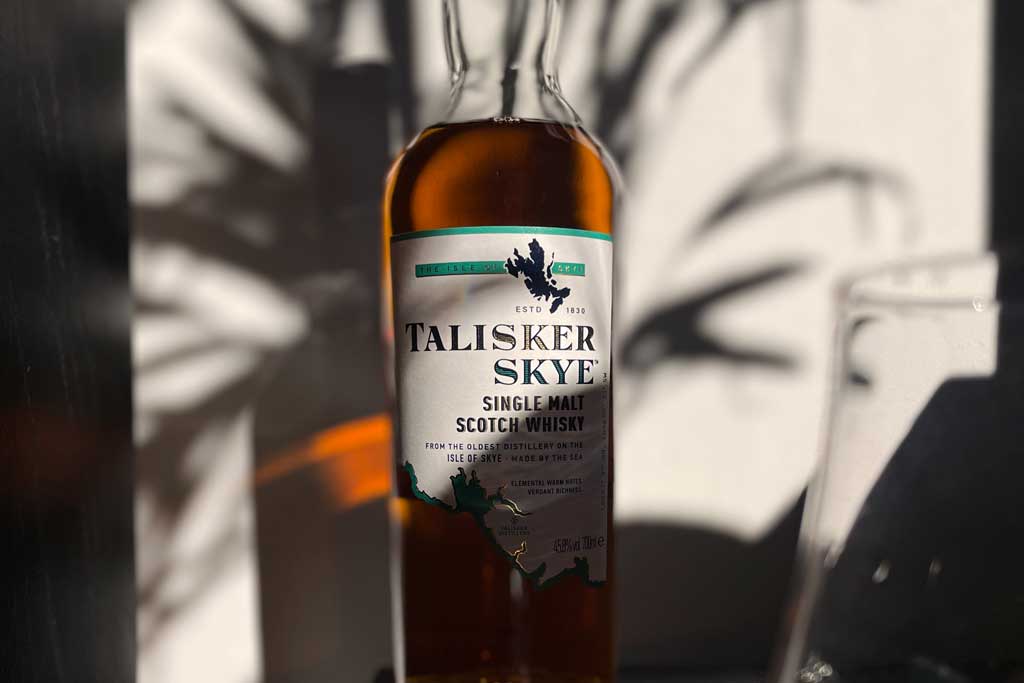
Final thoughts on Talisker Storm vs Talisker Skye
The Talisker Storm and Talisker Skye are two highly acclaimed single malts, each stemming from the distillery’s famous 10 year old expression. Each has its own unique character and flavour profile, making them both popular choices for whisky connoisseurs.
Our verdict
If you enjoy a smoky, peaty whisky, then the Talisker Storm is a great choice. Taking all the spicy aspects of a traditional Talisker, the Storm packs more of that signature smokiness, sulphur, salt and white pepper heat.
If you’re new to whisky and prefer a more subtle flavour, then the Talisker Skye is an easier, more gentle option. With an unusually subdued smokiness, this bottle lets the fruity, sweet notes come to the fore. For beginners, this bottle is less assertive than other Taliskers which could be a nice way to get on board with this fabled brand.
But…
If you’re still unsure (and want a more rounded Talisker experience), their 10 year old core-expression is similarly priced to the Skye and Storm. For good reason, this entry level bottle has been around for a while and won’t disappoint.
Sláinte.


